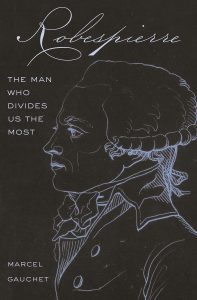In Robespierre : The Man Who Divides Us the Most, Marcel Gauchet explores the legacy of Robespierre as a tragic figure whose dual character embodied the contradictions of the French Revolution in representing both liberty and tyranny. With France today divided by political polarisation, this is a timely and provocative intervention, writes Leon Hughes.
Robespierre : The Man Who Divides Us the Most. Marcel Gauchet (translated by Malcom DeBevoise). Princeton University Press. 2022.
Find this book (affiliate link):![]()
 On 27 May 2022 Fanny Lescureux, President of the ‘amis de Robespierre’ (‘Friends of Robespierre’) association, accused a member of a militant and pro-Zemmour extreme right organisation agitating for a ‘France blanche’ (‘White France’) of attacking her and her mother in their home in Feuchy, Pas-de-Calais. Four weeks earlier, Marcel Gauchet published his translated work on Robespierre. Its subtitle, The Man Who Divides Us the Most, is a timely indictment of a France that is increasingly politically polarised.
On 27 May 2022 Fanny Lescureux, President of the ‘amis de Robespierre’ (‘Friends of Robespierre’) association, accused a member of a militant and pro-Zemmour extreme right organisation agitating for a ‘France blanche’ (‘White France’) of attacking her and her mother in their home in Feuchy, Pas-de-Calais. Four weeks earlier, Marcel Gauchet published his translated work on Robespierre. Its subtitle, The Man Who Divides Us the Most, is a timely indictment of a France that is increasingly politically polarised.
Gauchet, Professor Emeritus of the École des Hautes Études en Sciences Sociales (EHESS), proposes a striking argument in his book: that Robespierre was a tragic figure. Attempting to give liberty and equality ‘their most complete expression’, he failed to make a system of government from these principles, and instead had to ‘resort to terrorist violence in order to fill the gap between idea and reality’ (3). This led to two Robespierres: one inspirational, one repellent.
This is not a conventional biography: Gauchet makes clear that he will only consider Robespierre’s career from the start of the French Revolution as post-1789 Robespierre was ‘another man, as though he had undergone a conversion’ (10). Over six chapters, this bifurcated Robespierre is traced alongside the Revolution which, to Gauchet, he intimately embodied. The first five chapters detail his ‘ideas put into action’ (167), the sixth moves forward into encapsulating the continuing division that Robespierre causes in French society today.
In his first chapter, Gauchet details how, in 1789, ‘unbeknownst to him’, Robespierre’s discourse ‘contained the seeds of the utter destruction of an entire society and system of government’ (12). This seed was contained in his commitment to the Declaration of Rights and its grounding in legislative power as a hopeful ‘incorruptibility’ over the suspected despotism of a royal or ministerial executive. Robespierre begins to emerge as the embodiment of the promise of the Declaration.
Gauchet develops this in his second chapter as, in early 1792, Robespierre increasingly allied himself with ‘an idealised image of the people, and of himself as their spokesman’ (44). As the guide to the people, Robespierre developed a ‘sacrificial narcissism’ in which he ‘blinded him to himself’ (55) and produced a ‘dictatorial language’ of which ‘he became a prisoner’ (56). He became locked within Manichean logics: ‘between virtue in the service of the public welfare and corruption that knows only selfish self-interests, there was no middle ground’ (57).
Chapter Three details how, after 10 August 1792, Robespierre’s conviction that the people were the vehicle of virtue became confirmed. Yet, with the trial of King Louis XVI and Girondin-Montagnard factionalism, Robespierre’s growing conspiratorialism led him to necessarily conclude a ‘fight to the death’ (62) was developing. However, despite the people attaining a greater rhetorical power in his speeches, their conceptual vagueness ‘opened up the possibility of a regime with emergency powers’ (80).
Consequently, by 1793-94, Robespierre had become trapped within his own logics of conspiracy and came up against ‘the futility of his own vision’ (179). In his fourth and fifth chapters, Gauchet details the final stages of Robespierre’s career. He shows how Robespierre, installed in a position of power, no longer just spoke on behalf of the people, but began to exercise power in their name. Making a distinction between despotism for its own sake and temporary despotism for its own abolition, Robespierre resorted to attempting to save the Republic by institutionalising virtue through the Cult of the Supreme Being and increasingly violent attempts to cleave the virtuous from the unvirtuous.
Gauchet explains that Robespierre increasingly became ‘a prisoner of a way of thinking that transformed all resistance […] into a sign of despotism’ (145). He locates this mental imprisonment in the Declaration. With his only way of explaining himself from ‘first principles’ (145) on 8 Thermidor, Robespierre was imprisoned under charges of tyranny the day after by his fellow deputies who demanded tangible political answers. This is the culmination of Robespierre’s paradoxical ‘ideas put into action’: to himself he was the modest guide to an impersonal truth; however, his listeners heard the dictatorial monster that was to become his posthumous myth following his execution by guillotine in 1794.
In assessing Robespierre’s early ideas to explain the internal political dynamics of the Revolution, Gauchet aligns with the neo-Tocquevillian paradigm of his late mentor, François Furet. Yet, Gauchet sets a slightly different tone from Furet who, writing in the 1970s and explicitly critiquing totalitarianism, saw the Declaration as inevitably leading to the Terror of 1793-94. Gauchet agrees with Furet (1978) that the Declaration ‘took on a life of its own, until finally it succeeded in toppling a throne that had been secure for centuries’ (169). However, he holds more sympathy for the revolutionaries and their project, and his Robespierre becomes a tragic figure fatally caught up in his own self-aggrandising logics.
Despite being hugely influential in the historiography of the French Revolution, Furet has declined in popularity in Anglo-American scholarship which has increasingly moved away from his revisionist poststructuralism. Lynn Hunt (2009) saw this as one pole, the other being Marxist approaches, which has led studies of the French Revolution into an ‘interpretative cul-de-sac’. Translating Gauchet’s work into English hence holds potential to reintroduce Furetian revisionism into a firmly empiricist Anglophone context.
However, this still has its difficulties. Gauchet’s work is provocative, but also suffers from a poststructuralist inertia, especially around the idea of ‘the people’. After some active engagement in Chapter One, this becomes a rather static term in the later chapters. Moreover, by only considering Robespierre’s ideas, Gauchet can justify his limited and unreferenced source base: the Oeuvres complètes de Maximilien Robespierre (eleven volumes) with some supplementary material from fellow Montagnard Saint-Just and several assembly debates. This also leads to an implicit recognition of prior scholarship without critical engagement, Gauchet’s repeated use of Giorgio Agamben’s term ‘state of exception’ being one example.
The real promise in Gauchet’s work is with Robespierre-as-hauntology: a ghost the French are still trying to figure out how to exorcise. Gauchet considers this in his last chapter: should Robespierre be left to fall away in the hope of starting afresh, or must one come to terms with the Revolution through ‘trying to make sense of [Robespierre’s] dual character’ (4)? This is the continuing problem of the French Revolution for both Gauchet and Robespierre: how to finish it.
Gauchet concludes rather hopefully that the division between idealism and realism ‘seems at least in part dispelled’: ‘France appears to have found a way, if not to resolve the dilemma, then at least to make it more tractable’ (8). Yet, given the contexts of the deeply divided recent French legislative elections and the alleged attack on Lescureux, the delay in translation between 2018 and 2022 has left Gauchet’s more hopeful conclusions seeming dated. However, this does not weaken Gauchet’s argument: Robespierre is still the man who continues to divide the French, and this work is a timely intervention in a France which continues to be fatally politically polarised.
Note: This article first appeared at our sister site, LSE Review of Books. It gives the views of the author, not the position of EUROPP – European Politics and Policy or the London School of Economics. Featured image: The Arrest of Robespierre, ‘The Night of the 9th to 10th Thermidor, Year II, 27th July 1794’ by Jean-Joseph-François Tassaert, Source: www.bridgemanart.com (Public Domain)





